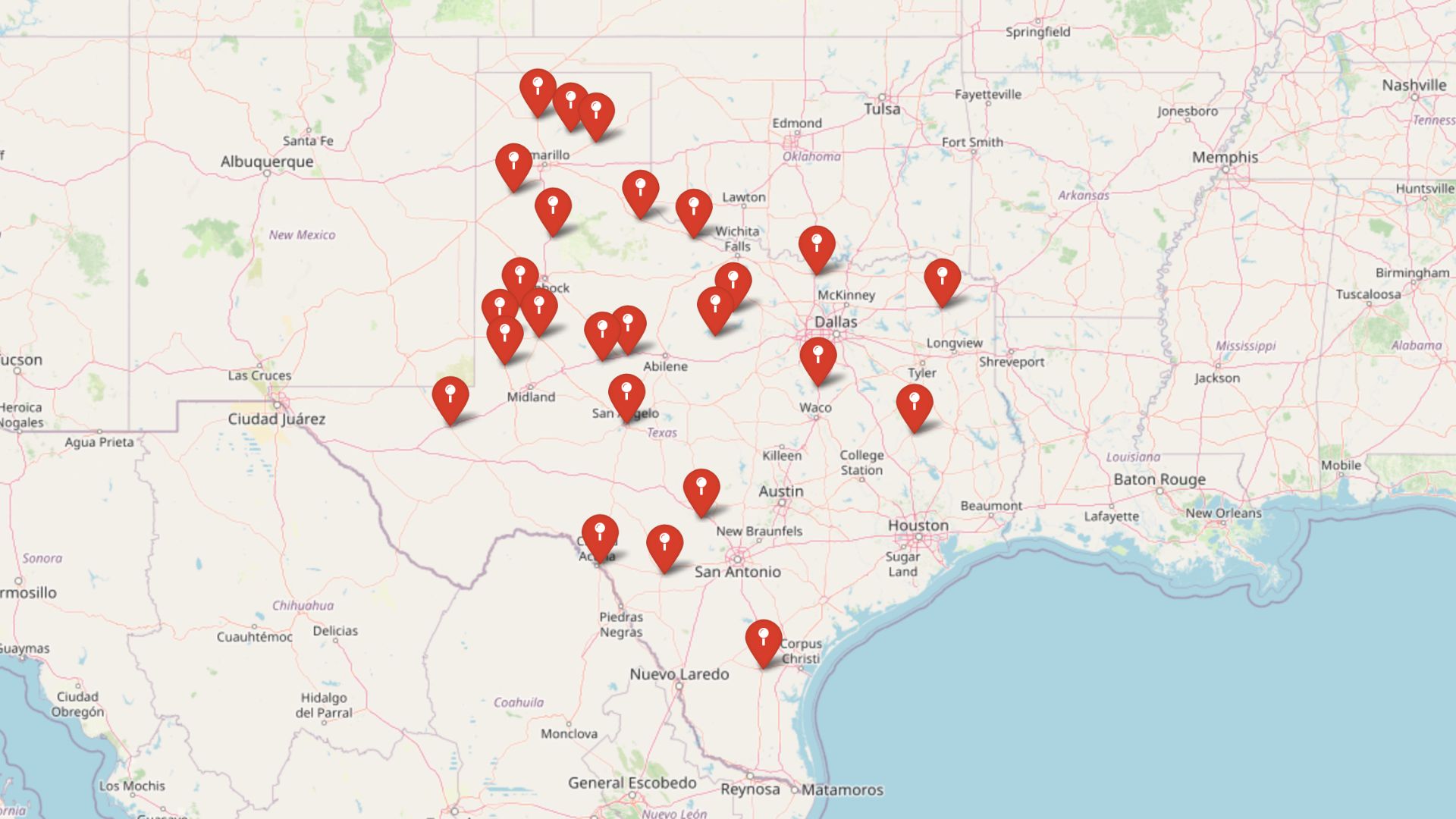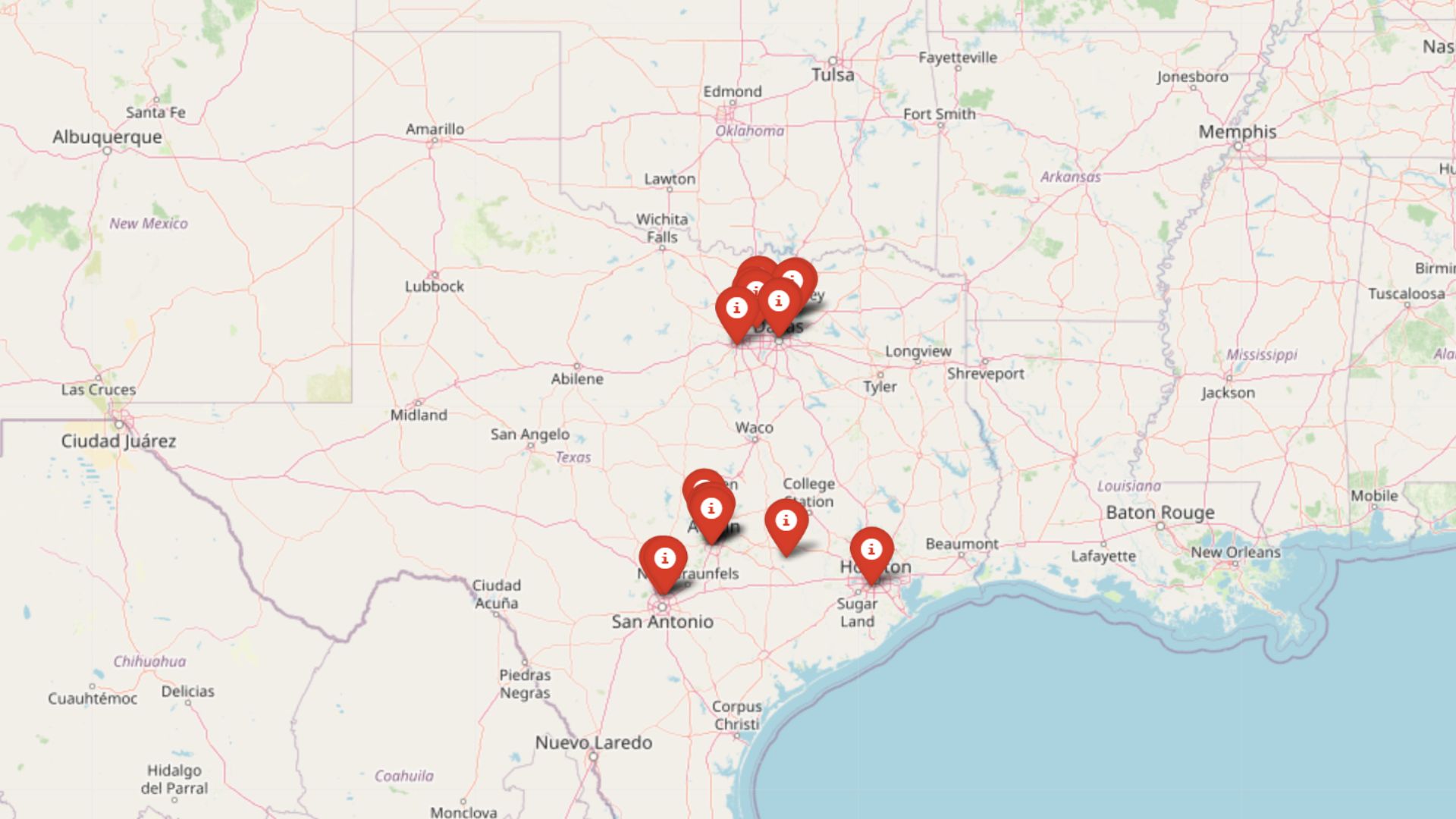
In far West Texas, just beyond the city lights of El Paso, the Franklin Mountains rise like a jagged backbone against the desert sky. Stretching north into New Mexico and flanked by wide, empty basins, this is where Texas tapers off—not in ambition, but in noise. Out here, towns like Dell City, Clint, and Butterfield remain small by design and isolated by geography.
Seclusion, in this region, isn’t an escape so much as a default setting. Residents trade proximity for peace, and the result is a string of communities where time moves differently. Cell service is spotty. Neighbors are few. But ask anyone in Fort Hancock or Hueco Tanks Village what keeps them here, and the answers echo: space, silence, sky.
These 10 towns dot the margins of the Franklin range, tucked into canyons, foothills, and valleys carved more by weather than by developers. Some are sustained by farming, some by history, and some—like Cornudas—by the simple fact that there’s nowhere else quite like them.
There’s a kind of clarity out here. The noise of the state’s booming metros doesn’t reach this far, and that suits locals just fine. In a part of Texas where the land itself resists intrusion, these places offer more than just quiet—they offer a way of life.
Here are 10 towns across the Franklin Mountains where isolation isn’t a flaw, it’s a feature.
10. Fabens: Small-Town Serenity Along the Rio Grande

Fabens, with a population of around 8,000, is a quaint town that offers a peaceful atmosphere along the Rio Grande. Residents enjoy local activities like fishing, bird watching, and exploring nearby farmland. Agriculture plays a significant role in Fabens, with cotton and pecan farming being primary industries.
The town’s seclusion comes from its vast open spaces and distance from larger urban centers, providing a tight-knit community feel. Hidden gems include local eateries serving authentic Tex-Mex cuisine and the annual Fabens Flight Fest, an event that celebrates the town’s aviation history.
Where is Fabens?

Located approximately 35 miles southeast of El Paso, Fabens sits near the border of Mexico along the Rio Grande. Its secluded nature is enhanced by the surrounding agricultural lands and the absence of major highways cutting through the town.
Access is primarily via Interstate 10, followed by a scenic drive along rural roads. This placement allows Fabens to maintain a serene environment, making it an ideal spot for those looking to escape the hustle and bustle of city life.
9. Clint: Agricultural Haven East of El Paso

Clint is a small town with a population of about 1,000, known for its rich agricultural heritage. Residents and visitors can enjoy horseback riding, visiting local vineyards, and participating in community events like the annual Cotton Festival.
The main industries in Clint revolve around farming and ranching, contributing to its quiet, rural ambiance. What makes Clint secluded is its expansive farmland and the sense of openness that comes with it. A hidden treasure in Clint is the Licon Dairy, where families can enjoy petting zoos and taste locally made cheese.
Where is Clint?

Situated 20 miles southeast of El Paso, Clint is nestled along the Rio Grande in El Paso County. The town’s seclusion stems from its location amidst large stretches of farmland and minimal urban development.
Access to Clint is primarily via Interstate 10, followed by rural routes that wind through picturesque fields. This setting offers a peaceful retreat while still being close enough to the amenities of a larger city.
8. Fort Hancock: Peaceful Border Town Living

With a population of around 1,700, Fort Hancock provides a quiet, rural atmosphere along the Texas-Mexico border. Outdoor enthusiasts can explore the nearby Fort Hancock wetlands and enjoy bird watching in this unique ecosystem.
The town has a rich history, once serving as a military installation, and now centers around agriculture and small local businesses.
Its seclusion comes from its remote location and the vast desert landscapes that surround it. An interesting fact about Fort Hancock is that it was featured in the movie “The Shawshank Redemption” as the dream escape destination.
Where is Fort Hancock?

Located approximately 55 miles southeast of El Paso, Fort Hancock sits along the Rio Grande in Hudspeth County. Its remote location and the scarcity of nearby towns contribute to its secluded nature.
The primary route to Fort Hancock is via Interstate 10, leading to a serene drive through the Chihuahuan Desert. The town’s isolation offers a tranquil environment, perfect for those seeking solitude and a connection with nature.
7. Butterfield: Tranquility Along Historic Trails

Butterfield is a small community with a sparse population, offering vast open spaces and a deep sense of tranquility. Activities in the area include hiking, horseback riding, and exploring remnants of historic trails used during the westward expansion.
The main industry is ranching, which complements the town’s quiet, rural lifestyle. Its secluded charm is due to its location away from main roads and urban centers. A hidden gem in Butterfield is the access to the old Butterfield Overland Mail route, a piece of history nestled in the desert.
Where is Butterfield?

Positioned northeast of El Paso, Butterfield is tucked away in the expansive landscapes of El Paso County. Its seclusion is accentuated by the surrounding desert terrain and lack of major highways nearby.
Accessing Butterfield involves traveling along lesser-known rural roads, adding to the sense of retreat. This isolation provides residents and visitors with an uninterrupted connection to the serene desert environment.
6. Newman: Rural Charm North of El Paso

Newman is a tiny, unincorporated community that offers a peaceful rural lifestyle north of El Paso. With a minimal population, it’s an ideal place for those who appreciate solitude and expansive land. Activities include exploring desert trails and enjoying the quiet of the surrounding nature.
The area is primarily supported by ranching and some small-scale industries. Newman’s seclusion is a result of its remote location and the vast stretches of undeveloped land that envelop it. A little-known fact is that Newman was once a stop on the historic El Paso and Northeastern Railway.
Where is Newman?

Located near the New Mexico border, north of El Paso, Newman sits off the beaten path in El Paso County. Its secluded nature comes from its proximity to the Franklin Mountains and the sparse population density.
Accessing Newman requires a drive along U.S. Route 54, followed by rural roads that lead into the quiet community. The town’s location offers stunning views of the mountains and a true sense of escape from city life.
5. Anthony Gap: Quiet Living Between Mountains

Anthony Gap is an area known for its serene environment nestled between the Franklin and Organ Mountains. While not a town in the traditional sense, it offers large properties and a tranquil setting perfect for those seeking privacy. Outdoor activities abound, including hiking, mountain biking, and wildlife observation.
The seclusion of Anthony Gap comes from its natural barriers—the surrounding mountains—which provide a peaceful enclave away from urban noise. An interesting spot is the nearby archaeological sites with ancient petroglyphs etched into the rocks.
Where is Anthony Gap?

Anthony Gap is located northeast of El Paso, accessible via U.S. Highway 54 and then along winding mountain roads. Its seclusion is due to the rugged terrain of the Franklin Mountains and limited access routes.
The gap itself is a pass between the mountain ranges, offering scenic views and a sense of remoteness. This location is ideal for those wanting to immerse themselves in nature while remaining within reach of nearby communities.
4. Hueco Tanks Village: Seclusion Near Historic Sites

Hueco Tanks Village is a small community adjacent to the famed Hueco Tanks State Park and Historic Site. With a small population, residents enjoy unparalleled access to world-class rock climbing, hiking, and exploring ancient pictographs.
The area’s main attractions revolve around outdoor recreation and the preservation of its rich history. Seclusion here is provided by natural barriers and strict development regulations that maintain the area’s tranquility. A hidden gem is the guided tours that delve into the area’s Native American history and geology.
Where is Hueco Tanks Village?

Situated about 32 miles east of El Paso, Hueco Tanks Village is accessible via U.S. Highway 62/180. Its secluded ambiance is due to the surrounding desert landscape and the protective boundaries of the state park.
The limited access points and the preservation efforts contribute to its peaceful environment. Visitors and residents alike value the solitude and the intimate connection with the natural and historical elements of the region.
3. Cornudas: A Hidden Gem on Highway 62

Cornudas is a tiny community known for its minimal population and the iconic Cornudas Cafe, a popular stop for travelers. Activities are centered around enjoying the quietude, stargazing, and exploring the surrounding desert. There are little to no main industries, adding to its untouched charm.
Cornudas’ seclusion comes from its remote location along Highway 62, with vast stretches of desert in all directions. A unique feature is the nearby Cornudas Mountains, offering opportunities for hiking and discovering desert flora and fauna.
Where is Cornudas?

Located about 60 miles east of El Paso along U.S. Highway 62/180, Cornudas sits near the border of Texas and New Mexico. Its isolation is due to the expansive desert and the lack of nearby towns.
Access is straightforward but requires a drive through uninhabited landscapes, enhancing the feeling of remoteness. Cornudas provide a true escape into the quiet beauty of the desert environment.
2. Salt Flat: Gateway to Guadalupe Mountains

Salt Flat is an unincorporated community with a small population, serving as a serene gateway to the Guadalupe Mountains. Visitors and residents can engage in hiking, wildlife viewing, and exploring the nearby salt flats that give the area its name.
The area lacks significant industries, which helps maintain its peaceful atmosphere. Seclusion is a hallmark of Salt Flat, with its expansive desert vistas and minimal development. A notable attraction is the proximity to the Guadalupe Mountains National Park, home to the highest peak in Texas.
Where is Salt Flat?

Situated approximately 85 miles east of El Paso on U.S. Highway 62/180, Salt Flat lies in Hudspeth County. Its remote location and surrounding natural features contribute to its secluded nature.
The community is accessed by a scenic drive through desert landscapes, with the mountains providing a dramatic backdrop. Salt Flat’s isolation offers an unparalleled opportunity to connect with nature in a quiet setting.
1. Dell City: The Oasis of Desert Serenity

Dell City, with a population of about 365, is a small agricultural community known as the “Valley of Hidden Waters.” Activities include visiting local farms, bird watching, and enjoying community events like the annual Hudspeth County Fair. Agriculture is the main industry, focusing on crops like alfalfa, cotton, and pistachios.
What makes Dell City secluded is its location amidst the vast deserts northeast of the Franklin Mountains, offering wide-open spaces and a peaceful rural lifestyle. A hidden gem is the Salt Basin Dunes nearby, featuring stunning white gypsum sand dunes.
Where is Dell City?

Located around 95 miles east of El Paso, Dell City is accessible via U.S. Highway 62/180 and then north on FM 1437. The town’s seclusion stems from its remote position near the border of Texas and New Mexico, far from major cities and highways.
The journey to Dell City involves traversing expansive desert landscapes, reinforcing its tranquil and isolated atmosphere. This oasis in the desert provides a unique retreat for those seeking simplicity and serenity.






